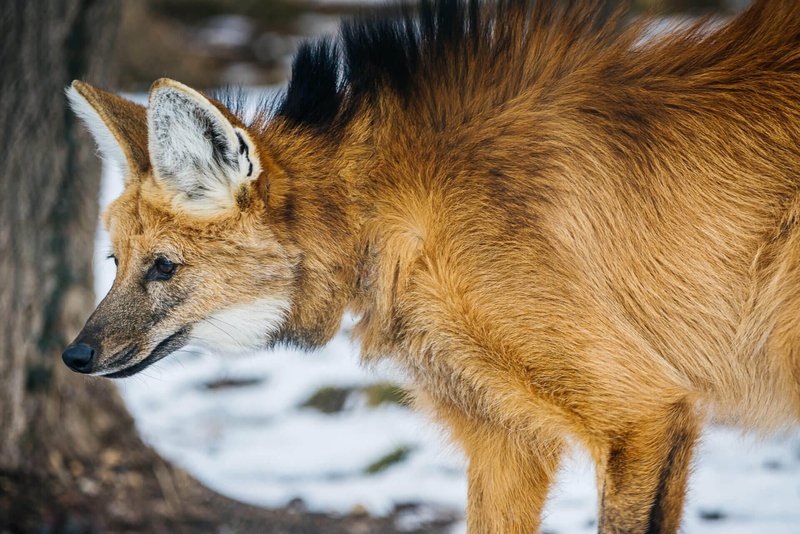
Maned wolves are primarily found in the grasslands and savannas of South America. They have distinctive reddish-brown fur and are known for their long, slender legs, which allow them to navigate their environment gracefully. They are also the largest canids in South America, standing about as tall as a large dog. But despite their somewhat intimidating appearance, the question remains: can these wolves pose a danger to humans? Let’s explore their behavior, habitat, and how they interact with people.
What Are Maned Wolves Like?
Maned wolves are unique creatures, not just in appearance but also in behavior. These animals are often described as being shy and elusive. They tend to avoid human contact and prefer to roam their habitats alone or in pairs. Here’s what you should know about their characteristics:
- Diet: Maned wolves primarily feed on fruits, small rodents, and insects. Their diet mainly consists of small prey, making them more of foragers than hunters.
- Behavior: Unlike traditional wolves that hunt in packs, maned wolves are solitary. This means they are less likely to encounter humans during their usual activities.
- Vocalizations: They have a range of vocalizations, including a distinctive “wolf-like” call. This call is mostly used for communication with other maned wolves during mating season.
With such gentle lifestyles, it’s easy to see why they rarely pose a threat to humans. Honestly, most of the time, they’re more interested in scrounging for food than causing trouble.
Do Maned Wolves Attack Humans?
When it comes to dangerous animals, the first instinct is often to think about attacks. But here’s the thing: maned wolves are not known for aggression towards humans. There are extremely few documented cases of maned wolves attacking people. In fact, they tend to be more afraid of us and will often flee at the sight of humans.
However, wild animals can be unpredictable. If a maned wolf feels threatened, especially if it has young pups, it might react defensively. But these situations are rare. Imagine walking in a park and encountering a deer; it might startle you, but the deer will usually run away. That’s quite similar to how maned wolves behave around humans.
Are They Endangered?
Interestingly, while they are not typically dangerous to humans, the maned wolf population is facing threats of its own. Habitat loss and hunting are significant challenges for these creatures. As humans expand into their territories, maned wolves find it harder to survive. Here’s a bit more on why their conservation matters:
- Habitat Destruction: Urban expansion and agriculture are leading to the destruction of grasslands and savannahs, which are crucial for maned wolves.
- Hunting: In some regions, maned wolves are hunted due to misconceptions about their danger or simply for sport.
- Genetic Diversity: A dwindling population can lead to inbreeding, affecting the species’ health and adaptability.
Conservation efforts are in place to protect these wonderful animals and their habitats. By supporting these initiatives, we can help ensure that maned wolves continue to roam the landscapes of South America.
How Do Maned Wolves Interact with Humans?
As mentioned, maned wolves tend to keep their distance from humans. But how do these fascinating animals actually interact with us? Generally, their encounters with people are minimal and usually harmless. Here are a few scenarios:
- In Protected Areas: In national parks or reserves, sightings of maned wolves can occur, and they may be accustomed to the presence of humans. Still, they will typically avoid close contact.
- Urban Areas: Occasionally, maned wolves wander into urban areas, but this is often due to habitat loss rather than a desire to interact with humans.
- Farming Regions: Farmers may sometimes see them as pests, but maned wolves mainly prey on rodents, helping control their populations.
While a curious maned wolf may capture attention, they are not typically aggressive. If you were to encounter one, giving it space would be the best course of action.
What Should You Do If You Encounter a Maned Wolf?
While it’s unlikely you’ll come face to face with a maned wolf, it’s good to know how to handle such an encounter if it happens. Here are some tips:
- Stay Calm: If you see a maned wolf, remain calm. They are likely just as surprised to see you.
- Do Not Approach: Keep your distance and do not try to approach the animal. Respect its space.
- Back Away Slowly: If you find yourself too close for comfort, back away slowly without turning your back on the animal.
Following these tips will help you coexist peacefully with these stunning creatures. Remember, they’re more scared of us than we are of them!
So, can the maned wolf be dangerous to humans? The short answer is no. These animals are shy, mostly avoid human contact, and pose little to no threat to us. They lead a solitary life, often more like a shy neighbor than a fearsome predator.
Understanding their behavior and protecting their habitats is key to ensuring they remain a part of our world. By learning about creatures like the maned wolf and supporting conservation efforts, we can appreciate their role in nature while respecting their space. So, the next time you hear a howl in the night, it might just be a maned wolf—a true marvel of nature, quietly living its life away from the hustle and bustle of humans.

